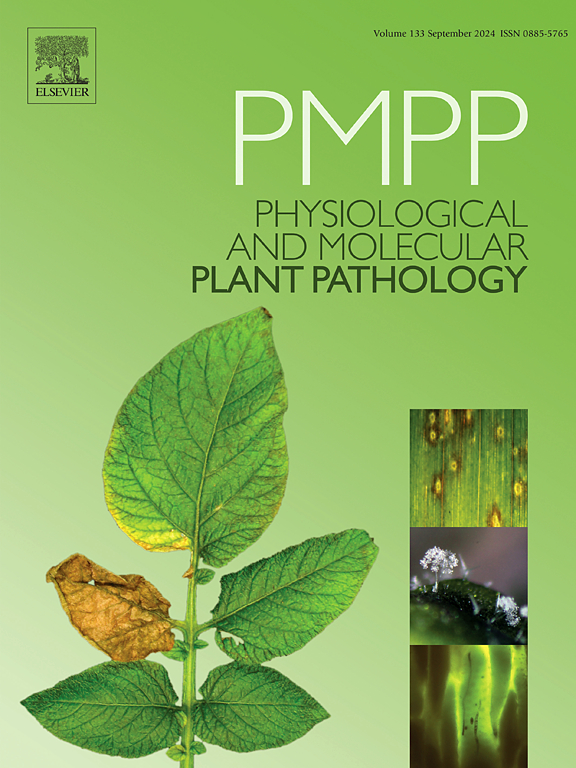Diversity of fungal species causing apple canker disease in India using multigene characterization
IF 2.8
3区 农林科学
Q2 PLANT SCIENCES
引用次数: 0
Abstract
Apple canker diseases are significant threats to the global apple industry, causing extensive damage, including shoot blights, stem cankers, and internal wood discoloration. This study aimed to investigate the symptomatology, disease incidence, and diversity of pathogens associated with apple cankers in three major apple-growing regions of India including the states of, Uttarakhand, Himachal Pradesh and Jammu & Kashmir (J&K). The survey revealed that canker symptoms typically begin as sunken spots on shoots and stems, which can progress to bark cracking and internal wood discoloration Disease incidence and severity varied across regions, with J&K showing the highest levels, particularly in Shopian (37.10 % incidence; 20.85 % severity). Himachal Pradesh also exhibited significant disease prevalence, with Shimla recording the highest severity (23.15 %). In Uttarakhand, Almora had the highest incidence (27.52 %) and severity (13.89 %). Isolations provided 38 isolates of Diplodia and Botryosphaeria spp., which were classified into four morpho-groups based on morpholo-cultural characteristics. Molecular analyses using the internal transcribed spacer region (ITS), beta-tubulin (β-tubulin) gene and translation elongation factor 1 subunit alpha (EF1-α), gene sequences identified four pathogenic species, namely, Diplodia bulgarica, Diplodia seriata, Diplodia mutila, and Botryosphaeria dothidea. Phylogenetic studies grouped these species into distinct clades with high bootstrap support. Pathogenicity tests demonstrated their role in causing canker symptoms under favourable conditions. This study presents regional variability in disease prevalence and identifies key pathogens responsible for apple cankers in India and highlights the need for development of effective management strategies.
印度苹果溃疡病真菌物种多样性的多基因鉴定
苹果溃疡病是对全球苹果产业的重大威胁,造成广泛的损害,包括茎枯萎病、茎溃疡病和内部木变色。本研究旨在调查印度三个主要苹果产区,包括北阿坎德邦、喜马偕尔邦和查谟的苹果溃疡病的症状、发病率和病原体多样性。克什米尔(J& K)。调查显示,溃疡病的症状通常始于芽和茎上的凹陷点,可发展为树皮开裂和木材内部变色。不同地区的发病率和严重程度各不相同,J&;K的发病率最高,特别是在Shopian(37.10%的发病率;20.85%严重程度)。喜马偕尔邦也表现出显著的患病率,其中西姆拉的严重程度最高(23.15%)。在北阿坎德邦,阿尔莫拉发病率最高(27.52%),严重程度最高(13.89%)。分离得到38株双孢子虫和植物孢子虫,根据形态培养特征将其分为4个形态类群。利用内部转录间隔区(ITS)、β-微管蛋白(β-微管蛋白)基因和翻译延伸因子1亚单位α (EF1-α)基因序列进行分子分析,鉴定出保加利亚双plodia、seriata双plodia、Diplodia mutila和Botryosphaeria dothidea 4种致病物种。系统发育研究将这些物种分为具有高引导支持的不同分支。致病性试验表明,在有利条件下,它们可引起溃疡症状。本研究提出了疾病流行的区域差异,确定了导致印度苹果溃疡病的主要病原体,并强调了制定有效管理策略的必要性。
本文章由计算机程序翻译,如有差异,请以英文原文为准。
求助全文
约1分钟内获得全文
求助全文
来源期刊
CiteScore
4.30
自引率
7.40%
发文量
130
审稿时长
38 days
期刊介绍:
Physiological and Molecular Plant Pathology provides an International forum for original research papers, reviews, and commentaries on all aspects of the molecular biology, biochemistry, physiology, histology and cytology, genetics and evolution of plant-microbe interactions.
Papers on all kinds of infective pathogen, including viruses, prokaryotes, fungi, and nematodes, as well as mutualistic organisms such as Rhizobium and mycorrhyzal fungi, are acceptable as long as they have a bearing on the interaction between pathogen and plant.

 求助内容:
求助内容: 应助结果提醒方式:
应助结果提醒方式:


